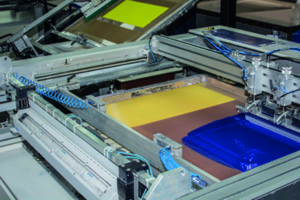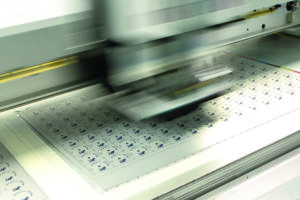How printing turned digital
‘Digital’ as a word experienced an explosion in its usage and in meaning throughout the 1900’s because of the evolution of modern computing.
This explosion has continued into many things and we find that ‘digital’ now prefixes many words changing or evolving the meaning of the word for example; digital watch, digital television and digital printing. Digital Printing works by ‘digitalising an image, dividing it into millions of tiny parts called pixels. The colour tone and shade of each pixel is encoded as a number. Using the numbers as instructions to direct where to place each coloured ink and in what quantities.
In 1974, when GSM Graphic Arts begun, we solely screen-printed required detail onto plates and labels. If multiple colours were required, a screen mesh would be created for each colour. Whilst the printing method of this ancient art remains the same, the creation of the screen has now been digitalised. Using specialist software, a digital photomaster is created which is then exposed onto the mesh screen using LED lights to create detail on the emulsion. The mesh is then fitted to a print bed where a screen printing team member will apply the ink using a squeegee. When screen printing, if multiple colours are required then for each colour we need to produce a screen mesh for the detail whereas digital printing uses a matrix put together by our studio team to see where to put the inks.

As the digital revolution has developed, we have relished the opportunity to invest in the latest technologies to enable us to be at the forefront of digital printing. As digital printing is reliant on computers and their evolution it may come as a surprise that digital printing onto paper didn’t come onto the market until the early 1990’s.
GSM Graphic Arts were early adopters of the digital printing phenomenon which then saw printing onto various plastics and metals evolve at quite a rapid pace. Although we have superseded the first digital printing machine we invested in over 15 years ago, continuous improvement has seen many investments into further technology and training to ensure that we remain established and highly experienced in the digital print field.

A testament to our experience would be that out of the 3 printers located in the UK that can print into metal, our digital suite house 2 of them. Print into metal digital printing is very popular because it enables the most industrious companies to have their logo’s gradient printed whilst also including a serialised number.
It is quite remarkable how adding the prefix ‘digital’ to printing has encouraged the industry to fully embrace, engage and evolve at such a speed. It continues to revolutionise the way we print onto metal and plastic. Sometimes there is a need for a lacquer to be printed to the front of a label or nameplate. Previously, we had to screen print this but now we can program the digital printer to acknowledge and print the areas we want the lacquer and avoid the areas we don’t want. This means that digital printing saves time.
We now have a guide which looks at whether to opt for traditional or digital printing for your labels.
